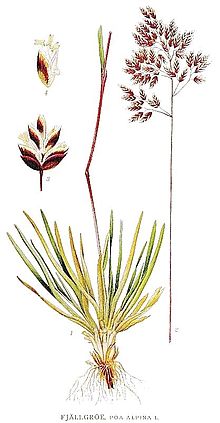Alpine bluegrass
| Alpine bluegrass | ||||||||||||
|---|---|---|---|---|---|---|---|---|---|---|---|---|

Alpine bluegrass ( Poa alpina ) |
||||||||||||
| Systematics | ||||||||||||
|
||||||||||||
| Scientific name | ||||||||||||
| Poa alpina | ||||||||||||
| L. |
The Alpine bluegrass ( Poa alpina ), also called Romeie in Switzerland , is a plant species from the bluegrass ( Poa ) within the sweet grass family (Poaceae). It is circumpolar in Eurasia and North America .
description
The alpine bluegrass is very rich in shape.
The Alpine bluegrass is a hibernating green, perennial herbaceous plant . It reaches a height of 15 to 30 centimeters. The culms are erect or kneeling-ascending, their surface smooth and bare. The stalks have two to four nodes that are also bare.
The leaves are green to gray-green and have only a very narrow, light-colored cartilage border. They are flat and 4 to 10 inches long. The ligule of the basal leaves is absent or almost absent (then truncated), that of the stem leaves is 3 to 5 millimeters long and torn, not pointed.
The flowering period extends from June to August. The panicle inflorescence is pyramidal, the lower branches stand out during the anthesis . The spikelets are usually tinged with purple. The spikelets are usually transformed into brood buds , this species is pseudoviviparous .
The number of chromosomes is 2n = 14, 28, 30-34, 33-46-74 to 74.
ecology
The Alpine bluegrass is a hemicryptophyte .
The main spread is through bulbils . In addition, gravity spreads because wet stalks lean down and the brood plants take root. Glue spreading of the husks covered with adhesive villi is also possible; in addition, Velcro spreads through sheep and wind spreads as snow runners .
By moderation fertilizing with rotted Mist the Poa alpina can be promoted, and by frequent Guellen be displaced.
Occurrence
The alpine bluegrass is distributed arctic-alpine circumpolar and occurs in the temperate zones of the northern hemisphere. In the south it occurs in North America to the Mexican state of Veracruz , in North Africa to Morocco. The main distribution is in the subalpine and alpine altitudes . In the Allgäu Alps , it rises at the summit of the Biberkopf to an altitude of 2600 meters. In the lowlands it occurs mainly only as a drift .
In Germany, the distribution extends from the Alps to the Lake Constance area , to Landsberg and Augsburg . It is common in Austria and is only absent in Vienna and Burgenland .
The alpine bluegrass grows mainly on fat pastures and meadows , also in storage areas and nutrient-rich snow-soil communities ( snow valleys ). It grows on fresh, nutrient-rich and base-rich, humus-rich loam and clay soils . It is an association characteristic species of Poion alpinae, but also comes in companies of the associations Rumicion alpini or Polygono-Trisetion ago.
Taxonomy
Synonyms of Poa alpina L. are u. a .: Poa alpina var. vivipara L. , Poa alpina subsp. vivipara (L.) Arcang. , Poa vivipara (L.) Willd. , Poa pratensis var. Alpina (L.) Huds.
use
The Alpine bluegrass is a good fodder grass. It is seldom cultivated as an ornamental plant in rock gardens.
literature
- Manfred A. Fischer, Wolfgang Adler, Karl Oswald: Excursion flora for Austria, Liechtenstein and South Tyrol . 2nd, improved and enlarged edition. State of Upper Austria, Biology Center of the Upper Austrian State Museums, Linz 2005, ISBN 3-85474-140-5 .
- Erich Oberdorfer : Plant-sociological excursion flora . With the collaboration of Theo Müller. 7th, revised and expanded edition. Eugen Ulmer, Stuttgart (Hohenheim) 1994, ISBN 3-8252-1828-7 .
- Rudolf Schubert , Klaus Werner, Hermann Meusel (eds.): Excursion flora for the areas of the GDR and the FRG . Founded by Werner Rothmaler. 13th edition. tape 2 : vascular plants . People and knowledge, Berlin 1987, ISBN 3-06-012539-2 .
- Siegmund Seybold (Ed.): Schmeil-Fitschen interactive . CD-ROM, version 1.1. Quelle & Meyer, Wiebelsheim 2002, ISBN 3-494-01327-6 .
Individual evidence
- ↑ a b c Poa alpina L., Alpine bluegrass. In: FloraWeb.de.
- ↑ a b Erich Oberdorfer : Plant-sociological excursion flora for Germany and neighboring areas . With the collaboration of Angelika Schwabe and Theo Müller. 8th, heavily revised and expanded edition. Eugen Ulmer, Stuttgart (Hohenheim) 2001, ISBN 3-8001-3131-5 , pp. 223 .
- ↑ Ruprecht Düll , Herfried Kutzelnigg : Pocket dictionary of the plants of Germany and neighboring countries. The most common Central European species in portrait . 7th, corrected and enlarged edition. Quelle & Meyer, Wiebelsheim 2011, ISBN 978-3-494-01424-1 .
- ^ Walter Dietl, Manuel Jorquera: meadow and alpine plants. Recognition by the leaves - delight in the flowers. 3. Edition. AV-Verlag, Zurich / Vienna 2007, ISBN 978-3-7040-2234-9 , p. 414.
- ↑ a b Rafaël Govaerts (Ed.): Poa alpina. In: World Checklist of Selected Plant Families (WCSP) - The Board of Trustees of the Royal Botanic Gardens, Kew . Retrieved November 12, 2016.
- ↑ Erhard Dörr, Wolfgang Lippert : Flora of the Allgäu and its surroundings. Volume 1, IHW, Eching 2001, ISBN 3-930167-50-6 , p. 184.
Web links
- Alpine bluegrass . In: BiolFlor, the database of biological-ecological characteristics of the flora of Germany.
- Profile and distribution map for Bavaria . In: Botanical Information Hub of Bavaria .
- Poa alpina L. In: Info Flora , the national data and information center for Swiss flora . Retrieved September 28, 2015.
- Distribution in the northern hemisphere from: Eric Hultén, Magnus Fries: Atlas of North European vascular plants. 1986, ISBN 3-87429-263-0 at Den virtuella floran. (swed.)
- Thomas Meyer: Data sheet with identification key and photos at Flora-de: Flora von Deutschland (old name of the website: Flowers in Swabia )


